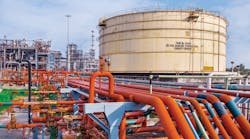Increased air pollution in India, resulting from a growing population, urbanization, vehicle emissions, and industrialization, has led the government to enforce tighter emission-control regulations and implement international pollution-reduction standards, reported Aarti Uplenchwar in a FACTS Inc. report released in mid-May.
India’s high population levels exacerbate its increasing pollution. The country’s urban population growth is about 270 million/year, and India has 3 of the world’s 10 most polluted cities: Delhi, Mumbai, and Chennai. Pollution in other cities also is reaching critical levels.
Vehicle emissions-one of the major causes of air pollution-are a major concern and the primary reason for such high particulate matter (PM) levels. Given the country’s rising population and income, total vehicle sales increased to 6.7 million in 2003-04 from 5.9 million in 2002-03 and the total number of vehicles in India grew by 14%, Uplenchwar said. There currently are 65 million vehicles in India. Two thirds of them are two and three-wheeled vehicles for which emission standards have also been set.
Emission norms adopted
To reduce PM levels, the government has adopted European emission norms and fuel quality regulations, which in India are called Bharat Stage norms. “The Bharat Stage norms follow the same emission standards as the Euro norms, but they are styled to suit specific needs and demands of Indian conditions and take into account the differences in geography and environment,” said Uplenchwar.
Indian refiners have upgraded their gasoline and diesel quality to implement the Euro I equivalent norms in the entire country, as well as the Euro II equivalent norms in the four required metro areas.
The norms are being introduced in phases, with Euro I compliance implemented nationwide in 2000, and Euro II in 11 cities in 2003. Euro II is scheduled to be applied nationwide this spring.
Euro III was to be executed in April in 11 cities, and nationwide in 2010, reported Uplenchwar. Euro IV is slated for introduction in 11 cities in 2010.
Refiners removed lead nationwide in 2000 and are reducing sulfur content to 500 ppm in 2005 from 1,000 ppm in 2000. India progressively has lowered the benzene content to a maximum of 3% nationwide and 1% in metropolitan areas, Uplenchwar said.
In diesel, the sulfur content was reduced to 2,500 ppm in 2000, and plans call for reduction to 500 ppm in 2005. The cetane number also has been improved to 48 since April 2000.
Costly implementation
The addition of desulfurization and treating facilities to implement the norms requires considerable funding.
“Because Indian refiners must bridge the gap in fuel quality in half the time it took their European counterparts, they are making huge investments in technological upgrades,” said Uplenchwar. The upgrading to Euro II equivalent standards will require $3.3 billion, while upgrading to Euro III standards will require $5.6 billion at existing refineries.
Uplenchwar questions whether the timetable for implementing these norms is realistic. Refineries are struggling to meet current deadlines, as the upgrades are not yet complete in all the refineries and some deadlines have had to be postponed.
“While on one side, India’s increasing vehicular pollution due to increasing development and per capita income warrants such regulation, it cannot be ignored that the Indian refiners are struggling to meet these norms.
“Low-sulfur gasoline and diesel have been imported to meet the April 2005 norms. While the Euro III norms will be implemented in 11 cities, Euro II diesel will not be available nationwide until August or September. This suggests that the pace of reform is not in tandem with the technological capability of the Indian refiners,” contends Uplenchwar.
In addition, he said, “In India most of the decisions to reduce air pollution are carried out on the orders of the Supreme Court, rather than by concerned authorities. While on the one hand, this has led to landmark decisions, on the other hand it has led to controversy on the feasibility of the fuel chosen by the Supreme Court, as well as inefficient implementation.”
Other initiatives
The automobile industry, too, has made significant investments to produce more environmentally friendly vehicles. From April 1995, new gasoline passenger cars sold in Delhi, Calcutta, Mumbai, and Chennai were required to have catalytic converters, which also meant that unleaded gasoline was made available in these areas. Unleaded gasoline has been available throughout the country since 2000.
In other initiatives, India is promoting the greater use of cleaner fuels such as liquefied petroleum gas and compressed natural gas. By January 2002, all diesel buses in Delhi were phased out, and by mid-2002, the number of CNG buses increased to 6,800 from 900 in May 2001, said Uplenchwar. In addition, more than 27,000 automobiles and 14,000 other vehicles are now running on CNG in Delhi.
Nevertheless, he suggested that India needs to take action on other measures to complement the Euro norms, such as preventing fuel adulteration, scrapping old vehicles, managing traffic, requiring vehicle inspections, and providing more public transportation. ✦

